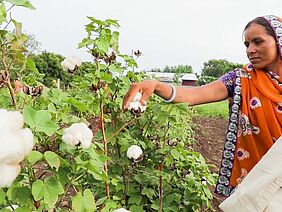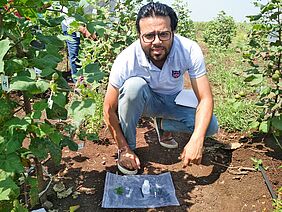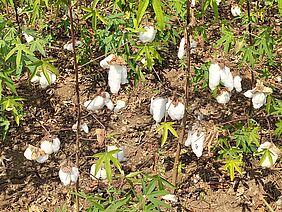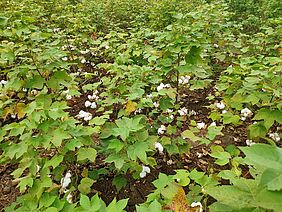(Frick, September 15, 2022) In recent decades, it has become increasingly difficult for farmers to obtain good quality organic cotton seed. On the one hand, genetically modified (GM) seeds from large companies dominate the market and threaten the purity of other varieties. On the other hand, traditional, non-GM seeds have not been sufficiently developed and often do not meet the expectations of farmers regarding yield and processors regarding fibre quality.
Therefore, the two recently notified new varieties are a success in the fight against the organic cotton seed crisis. The new varieties have been tested under organic conditions and officially released by the State Seed Sub Committee of Madhya Pradesh, the largest organic cotton-growing state in India. The Committee gave the green light to the two first-ever non-GM cotton varieties for organic agriculture on September 8, 2022. The released varieties are high-yielding and meet industrial fibre quality requirements. They are derived from two different cotton species: Gossypium arboreum, commonly known as traditional or Desi Cotton and Gossypium hirsutum, American upland cotton. Both were bred under organic conditions and are suitable for organic, agroecological, regenerative and low input farming systems.
Ten years of breeding work by farmers and scientists
The farmer’s knowledge and needs are reflected well in the two new varieties, which are a result of over ten years of breeding work. These improved varieties are the outcome of joint efforts made under the project "Seeding the Green Future". The project is a participatory organic cotton breeding program which directly supports smallholder farmers in India and strongly involves them in the research for development. "These varieties do not only improve agrobiodiversity and the livelihoods of smallholder farmers, but they also ensure their right to choose from Desi and American upland cotton without having any negative impact on productivity, profitability and quality of their cotton," says Amritbir Riar, project leader of the Seeding the Green Future (SGF) project and deputy leader of the Department of International Cooperation at FiBL Switzerland.
The project's main objective is to secure the availability of cotton seed free of genetic modification to improve the integrity of the organic cotton value chain. Monika Messmer, an avid plant breeder and deputy leader of the Department of Crop Sciences at FiBL Switzerland, mentions: "The SGF project focuses on the conservation and use of genetic diversity. To avoid GM contamination, using the native, more robust Desi cotton varieties was an important strategy. These species have morphologically distinct leaf shapes compared to the GM-hybrids and different chromosome numbers making cross-pollination extremely rare".
Tanay Joshi, SGF project coordinator at FiBL, emphasises the importance of participatory breeding, "The innovative model of collaboration is an example of the amalgamation of formal and farmer-managed seed system. It has the potential to scale up decentralised cotton breeding initiatives resulting in non-GM cotton varieties that meet the fibre quality requirements of the textile industry."
Technical details on the two new varieties
- The non-GM Desi Cotton variety RVJK-SGF-1, developed by scientists from RVSKVV, PSL (see list of partners below) and FiBL Switzerland, has been found to be 21.05% superior in seed cotton yield over the benchmark variety. The variety has a good fibre length (28.77 mm), a high fibre strength (27.12 g/tex) and it matures in 144-160 days after showing.
- The non-GM American Cotton variety RVJK-SGF-2 developed by scientists from RVSKVV, Chetna Organic (see list of partners below) and FiBL Switzerland exceeded the benchmark by 21.18% for seed cotton yield and is a medium tall (96-110 cm) type plant of medium maturity group and matures in 145-155 days after showing. The variety has – as per the industrial requirements – long fibres (29.87mm) and a high fibre strength (29.92 g/tex). It is also found to be suitable for 20s to 50s count spinning to make a good quality fabric.
Both varieties reported mild to moderate resistance to sucking pests and pink bollworm and show wider adaptability to local organic cultivation conditions.
Further information
FiBL contacts
- Amritbir Singh Riar, Deputy leader of the Department of International Cooperation, FiBL Switzerland
- Franziska Hämmerli, Deputy leader of the Group Project communication, FiBL Switzerland
Supporters
- stiftung-mercator.ch: Stiftung Mercator Schweiz
- organiccottonaccelerator.org: Foundation OCA (Organic Cotton Accelerator), The Netherlands
Partners
- pratibhasyntex.com: Pratibha Syntex (PSL)
- chetnaorganic.org.in: Chetna Organic
- cottonconnect.org: CottonConnect
- asaindia.org: Action for Social Advancement (ASA)
- rvskvv.net: Rajmata Vijayaraje Scindia Krishi Vishwavidyalaya, Gwalior University (RVSKVV)
- pdkv.ac.in: Dr. Panjabrao Deshmukh Krishi Vidyapeeth, Akola University (PDKV)
- csa-india.org: Centre for Sustainable Agriculture (CSA)
Links
- sgf-cotton.org: Project homepage
- youtube.com: Video "Participatory breeding to secure income of organic cotton farmers in India" from the project Seeding the Green Future (SGF)
- fibl.org: International FiBL cotton project honoured with research prize
- sfiar.ch: SFIAR Award Ceremony 2021 - Outcomes
- fibl.org: Activities on organic cotton
Scientific literature
- Riar, A., Joshi, T., Messmer, M. 2021. Participatory On-Farm Breeding of Organic Cotton. www.fibl.org/en/shop-en/1185-participatory-cotton-breeding
- Riar, A., Messmer, M. 2021. Participatory organic cotton breeding approach to achieve sustainable development goals. In: Abstract E-Book. International Conference on Breeding and seed sector innovation for organic food systems. 8-10 March 2021, Online from Latvia, p. 176. https://orgprints.org/id/eprint/43501/
- Vonzun, S., Messmer, M., Boller, T., Shrivas, Y., Patil, S., Riar, A. 2019. "Extent of Bollworm and Sucking Pest Damage on Modern and Traditional Cotton Species and Potential for Breeding in Organic Cotton" Sustainability 11, no. 22: 6353. https://doi.org/10.3390/su11226353







